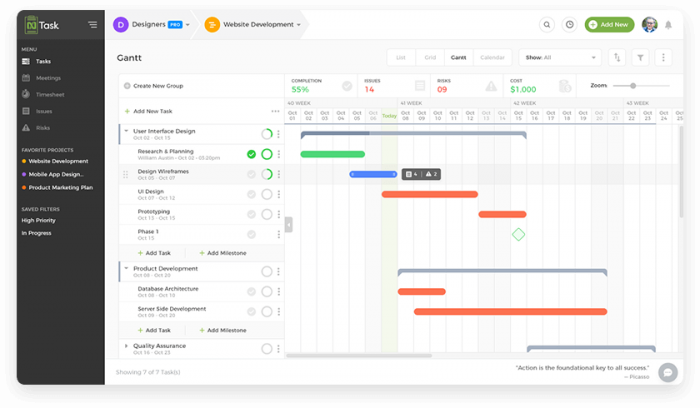Project management is a complex jumble in which the elements related to a project development process are dependent on each other in order to make the overall process a success.
One thing that you need to note is that the tasks related to the project development process are divided into two types.
- Main tasks that fuel the growth
- Support activities that help the completion of the main tasks
So, when we talk about Level of Effort or LOE, it is a project management terminology that points to a specific type of project or product development activity known as support activities.
These support activities can be of many different shapes and forms, and the most common of them are updating the documentation of the project, submitting the expenses, and maintaining the equipment being used by the development team, etc.
Let’s take a look at these different support activities in detail and find out how they can be beneficial for us if we perform them timely.
Different Examples of Level of Effort
Here is a list of some examples of Level of Effort that we will see to find out how these support activities are present in almost any project in the organizational paradigm.
- Updating the Reports of the Project
- Managing the Stakeholders
- Communicating with Customers
Let’s take a look at these support activities in detail.
1. Updating the Reports of the Project
When we talk about any type of project in the organizational paradigm, we know that they require a lot of thorough documentation in the form of project reports.
These reports consist of all of the different progress points and the milestones that the project needs to achieve.
One other benefit of these reports is that you can use them and compare them with the project plan that was discussed at the start of the development process, to check whether the project development is on track or not.
A common example of these types of reports is a budget report.
To make sure that your team creates an accurate budget report, they must keep track of all of the different expenses and their receipts, also the communication with stakeholders and the cost changes related to the project.
2. Managing the Stakeholders
Stakeholders are the backbone of every project. So, naturally, when we talk about any successful project, it is a given that the stakeholder management in that project development process was very successful.
Managing the stakeholders of any project requires constant communication and transparency regarding any and every activity that is being performed in the project development process.
Depending on the type and size of the project being developed, the LOE for the stakeholder management process will go up or down, but the development team must know about the energy it is going to take.
3. Communicating with Customers
Customer communication is very important in the project development process. Especially in the days of online reviews where a single review or suggestion can make or break your business.
Also, customer communication with the team can be perfect when it comes for the business to update its services because they can simply tell the team what to update and what not to.
Why is Calculating LOE Important?
Whenever we talk about resources associated with a project development process, we think about money and materials, and we completely overlook one key resource at our disposal, and that is effort.
Effort is like a resource that should be properly calculated by the project managers because if the development team members know about the effort that each task is going to require, before even starting their work, they are going to be better off.
This is because most of us in the organizational paradigm start our day by measuring our tasks, and if we know about the LOE of different tasks and processes, we will prioritize them more efficiently.
When should Level of Effort be Measured?
The best practice to measure the Level of Effort is to do it in the planning phase when the tasks and processes for the project development process or a specific product or project are being created.
It is common knowledge that tasks that have a higher level of effort associated with them require quite a lot more work than the normal tasks. So, calculating LOE is vital as it provides an accurate idea about the effort that your team has to put in.
Let’s now take a look at how we can calculate the Level of Effort and benefit our project and the development team.
How to Calculate LOE?
We have discussed in this article, the importance and the whole concept of Level of Effort.
But now we must take a look at how we can calculate the LOE by examining a real-world example of managing a project to improve the communication among the different team members of the development team, by using these three steps. They are:
- Using an Effort Estimation Technique
- Deciding how Accurate Your Estimates should be
- Adding values to the Level of Effort Scale
Let’s take a look at these steps in detail and find out how they can help us in calculating the Level of Effort for our tasks and processes.
1. Using an Effort Estimation Technique
One of the first things that you do when starting a project development process is creating a task list that your team is going to be working on until project completion. Now you have to estimate the effort it is going to take to complete them, and for that, you can use these three ways:
- Sort into Categories
- Rank by Priority
- Assign Numerical value
All of these methods for effort estimation are acceptable, as long you use the same metric to measure all of the tasks equally.
Also, you need to take general management and upkeep hours into account, because most of the support activities that are a part of the project development process don’t have a proper stopping point, until and unless the whole project development process is completed.
2. Deciding how Accurate Your Estimates should be
Accuracy is always important in all walks of life, but when it comes to the projects in the organizational paradigm, some of them require a higher level of accuracy than the other tasks.
This is because these tasks and processes are very important to the overall project development process, and if they are not done accurately, the whole project is going to crash and burn.
3. Adding values to the Level of Effort Scale
When you have completed the effort estimation of all of the tasks and processes of the project development process, each of them must be allocated a number of some sort of value to categorize their level of effort.
You can rank these tasks from lower to the highest so that the team members can know what they are getting into and can prepare their strategy to perform these tasks.
Conclusion
This was a short guide on the Level of Effort that we as people of the organizational paradigm can use right now.
If you want to add something to this article, or if you want to report something incorrect that is mentioned here, contact us and we will check it out promptly.


